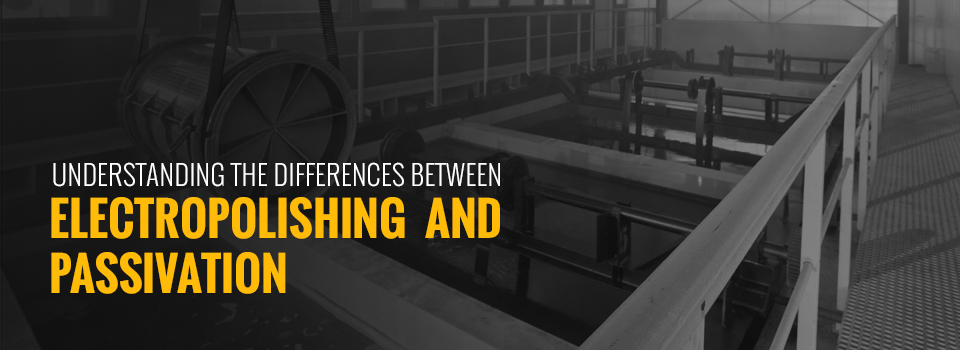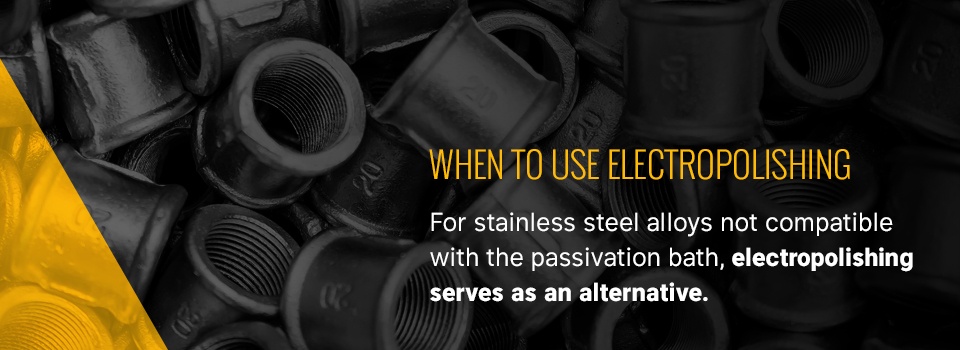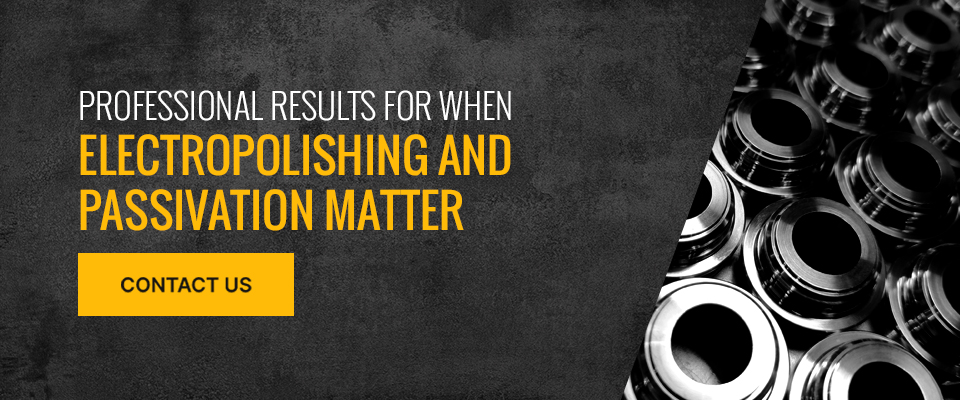Understanding the Differences Between Electropolishing and Passivation

Creating a corrosion-resistant surface on stainless steel typically requires the use of passivation, electropolishing or both. Though manufacturers use both for protecting the surface of parts, you will find a significant difference between electropolishing and passivation. One option does not offer universal performance for all parts.
When it comes to electropolishing vs. passivation, either process could perform better for your components. The details of your job matter as well as the benefits of these techniques for certain parts. Which do you need for corrosion resistance? Decide for yourself based on the uses and advantages of these methods to build surface protection against corrosion.
What Is Electropolishing?
The process of electropolishing stainless steel occasionally goes by the term “reverse plating.” While plating applies a thin layer of metal onto a surface through an electrochemical reaction, electropolishing removes surface imperfections through electricity and chemistry.
How Does Electropolishing Work?
The process of electropolishing follows three main steps — preparation, electropolishing and finishing.
During preparation, the worker cleans and rinses the metal parts. This portion of the procedure is critical in getting rid of surface dirt and grease that could impede the electropolishing process.
Then the electropolishing process occurs. A chemical bath in a rubber-lined steel tank will hold the parts and the electrodes during the process. A power source transforms AC power to DC power. To the negative side of this power source, the worker attaches cathode plates made of either copper or stainless steel. The parts that undergo electropolishing hang from a metal rack that connects to the positive side of the power source, the anodic. When the power comes on, it sends a current through the electrochemical bath to remove burrs and surface imperfections from the parts. These burrs and other metal ions travel toward the cathode but get dissolved in the bath during the process.
After the electropolishing process, workers thoroughly rinse and dry the parts to remove any remaining electrolyte solution.
Electropolishing Benefits and Applications
What are the Advantages of Electropolishing?
Electropolishing removes physical burrs and other imperfections, producing parts that look shiny, have smooth surfaces and resist corrosion. Depending on the requirements of your job, you may need to select electropolishing to get the results you need.
Is Electropolishing Better than Passivation?
Electropolishing offers some benefits over passivation, such as better performance in fatigue testing in wet and dry conditions compared to passivation.
Additionally, electropolishing produces more finely polished surfaces compared to mechanical polishing. Passivation does not polish the surface, so you should choose electropolishing if you need to remove surface imperfections that mechanical polishing cannot reach.
Finally, no alloys fall outside the capabilities of electropolishing. By customizing the bath ingredients, a polisher can create a corrosion-resistant surface on almost any stainless steel alloy, even those that do not accommodate passivation.
Other advantages of electropolishing include a bright finish, improved microfinish, deburring and high-performance corrosion resistance.
When Should You Use Electropolishing?
For stainless steel alloys not compatible with the passivation bath, electropolishing serves as an alternative. You can also use this method if you need polishing or deburring of intricate parts that you cannot mechanically polish.

What are the Most Common Electropolishing Applications?
Industries that use this method include food and beverage processing, biochemical, pharmaceutical and automotive. More specific uses within these industries and others include piping, tubing, medical equipment, surgical instruments, off-shore rig components, water treatment filters and paper mill slurry pipe systems.
What Is Passivation?
The passivation process uses chemical reactions to make stainless steel less susceptible to corrosion. The process uses acid to remove anodic surface contamination, such as particles of free iron. The most commonly used acid in the industry is nitric acid, though citric acid is preferred in some cases. By removing the surface contaminants, a protective oxide layer on the exterior of the part forms. This passive oxide layer protects against corrosion.
How Does the Passivation Process Work?
As with electropolishing, the first step of the passivation process requires cleaning the parts to prepare them for the solution. The cleaning step removes grease, dirt, dust and other surface contaminants. How this cleaning happens depends on the part. Processes to remove surface grease and dirt may include vapor spraying, swabbing or immersing in cleaning agents.
After a complete cleaning of the parts, they will undergo passivation. The acid dip stage of the process requires a deep knowledge of the chemistry of the acid mixture used and how to adjust it based on the materials treated. Success depends on the acid used, the recipe for the acid mixture, bath temperature and duration of the dip. If done correctly, this portion of the process should remove all free iron from the surface to allow for an even oxide layer to form.
Rinsing off the parts is the final step. Depending on the formula used in the bath and the parts, the worker may opt to dip the components in a neutralization bath, followed by water rinsing. Again, expertise in what to do during this portion of the method will determine the success of the entire passivation process.
Passivation Benefits and Applications
The benefits and uses of passivation make it a preferred method for creating corrosion resistance in certain situations. If you have a job that could benefit, consider passivation to protect the surface from wear.
What Are the Advantages of Passivation?
Passivation requires fewer steps compared to electropolishing. When it comes to static mechanical testing, passivation performed equally as well as electropolishing.
For applications where you want to change the thickness of the oxide layer, passivation allows you to do this while electropolishing does not. This thickness control serves as the main advantage of passivation over electropolishing.
What Are the Benefits of Chemical Passivation?
Though the passivation process occurs naturally over a couple of days, choosing chemical passivation ensures the production of this natural corrosion resistance in a controlled environment at a faster speed. The process of chemically passivating parts lets you control the level of protection the surfaces have.
What is Passivation Used For?
Passivation works for many applications. In fact, NASA uses passivized parts at Kennedy Space Center (KSC) on ground support equipment and shuttles. Most passivized parts are welded joints and fasteners.
Other uses for passivation include components for the medical, military and aerospace industries.
Professional Results for When Electropolishing and Passivation Matter
Parts that use electropolishing or passivation depend on the precision of the process. Professionals will provide your products with optimum results when corrosion resistance is crucial.
At Hard Chrome Specialists, we take pride in our work. As a family-owned and operated company since 1988, we continue to use the same customer-first approach and high caliber of service that has made us a trusted source for plating and other services for decades. Let us handle your electropolishing or passivation job to get results that perform to your expectations. Contact us at Hard Chrome Specialists for more information.

